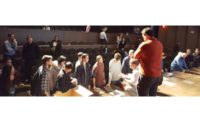Second Annual COMPOSITES CHALLENGE Winners at AIA 2017

A team of students from Clemson University has won the second annual COMPOSITES CHALLENGE presented by the American Composites Manufacturers Association, supported by Ashland LLC and coordinated by David Riebe of Windsor Fiberglass.
The challenge is an exciting student design competition focused on finding innovative ways to integrate composite constructions into architectural production. For its second year, ACMA and Ashland invited a select group of institutions to participate - including Clemson University, the University of  Southern California, the University of North Carolina Charlotte and Kent State University.
Southern California, the University of North Carolina Charlotte and Kent State University.
Clemson University architecture students stand with their winning "MANIFOLD" design.
The architectural students from these schools were asked to work in teams to consider the development of a composite architectural building component or assembly. The teams were encouraged to explore and design innovative structures that demonstrate how composites can be used to challenge convention and save costs on construction. Industry experts from distributor Composites One played a critical role in the challenge by providing the teams with the materials and knowledge they needed to create their innovative designs.
"The collaboration that emerged is a very positive sign for the future," said Riebe. "What began with industry experts introducing students to composite material systems during the introductory workshops evolved into an exciting and ongoing partnership between industry and academia. The breadth of work and imagination generated by tomorrow's practitioners is truly remarkable, and a real sign that composite material systems will become ever more central to the next generation of building practices."
Clemson's "MANIFOLD" team came in first place. The design deviated from traditional mold-making methods by applying folding techniques that capitalize on fiberglass composites' flexible textile qualities to create a complex and structural full-scale column.
Two teams from the University of Southern California tied for second place. The first design, "The Incubator," is a proposed extension of the university's Marshall School of Business. The Incubator is a modular structure with composite panels designed to allow daylighting throughout the building to create an open environment for students.
USC's second team, "Plug 'N' Play," is also a proposed design for a satellite campus for the Marshall School of Business. As the team explains, the site faces challenges of constrained accessibility for construction, poor daylighting, a narrow floorplate, and strict building regulations. Composites help overcome these challenges and serve as a viable replacement for steel.
A separate team from Clemson finished in third place with "Columns of Double Curvature." Like the university's first place team, the third place team created a unique column without the use of traditional mold techniques. However, instead of folding, the team used a rotisserie-like jig to weave fibers to create columns with a "double curvature."
"The ACMA Composites Challenge was an excellent opportunity for all," said Joseph Choma, Assistant Professor, Clemson University. "It began with industry leaders sharing their expertise, and ended with students and faculty sharing their design research investigations. The reciprocal dialogue between industry and academia energized the explorations - knowing that what we do could contribute to advancements in composites manufacturing for architectural applications."
The two top teams will be awarded cash prizes, and each of the winners' work will be on display in the CompositesBuild.com booth at the Composites Pavilion at the 2017 American Institute of Architects (AIA) Convention (April 27-29 in Orlando, Fla.). For more information visit http://compositespavilion.com/composites-challenge/.
Looking for a reprint of this article?
From high-res PDFs to custom plaques, order your copy today!





